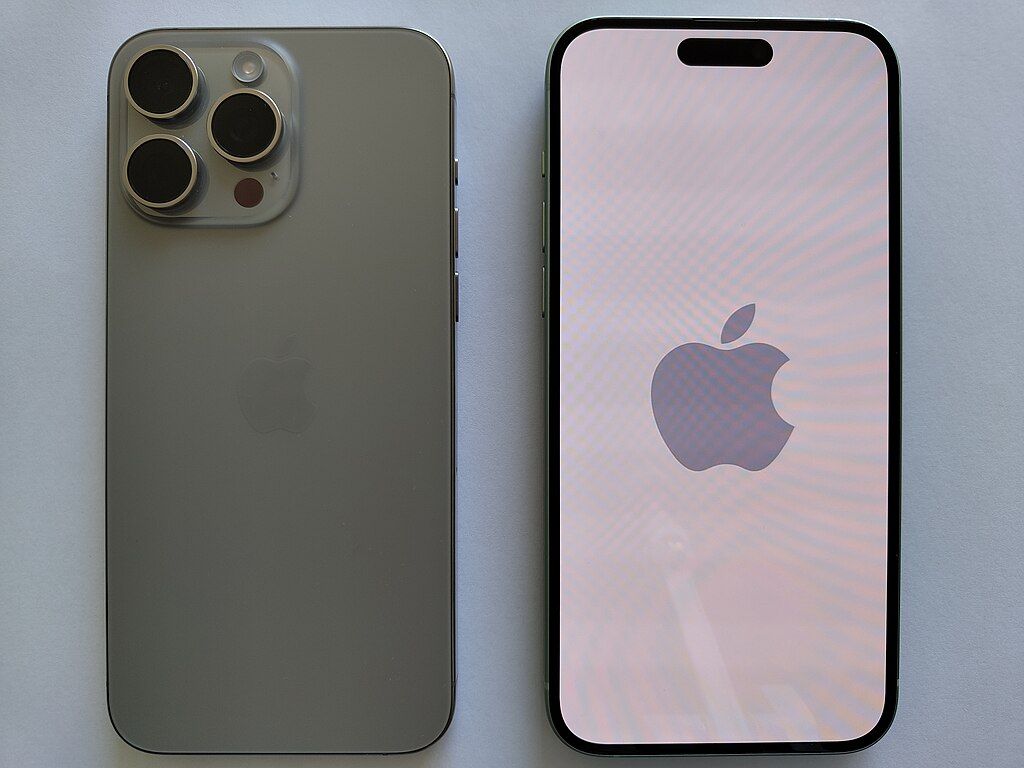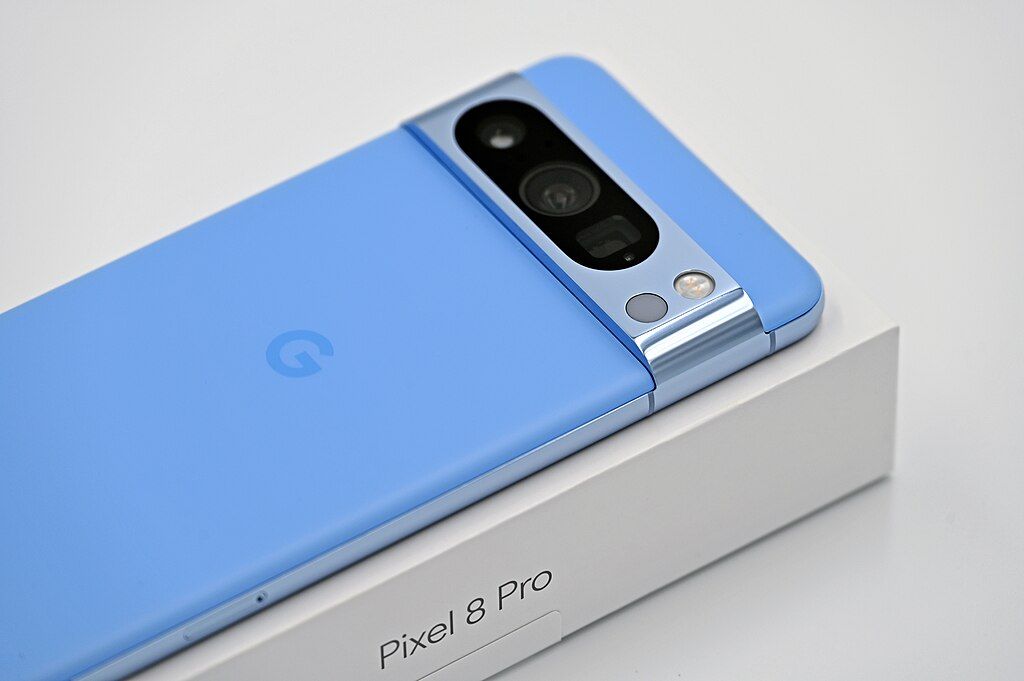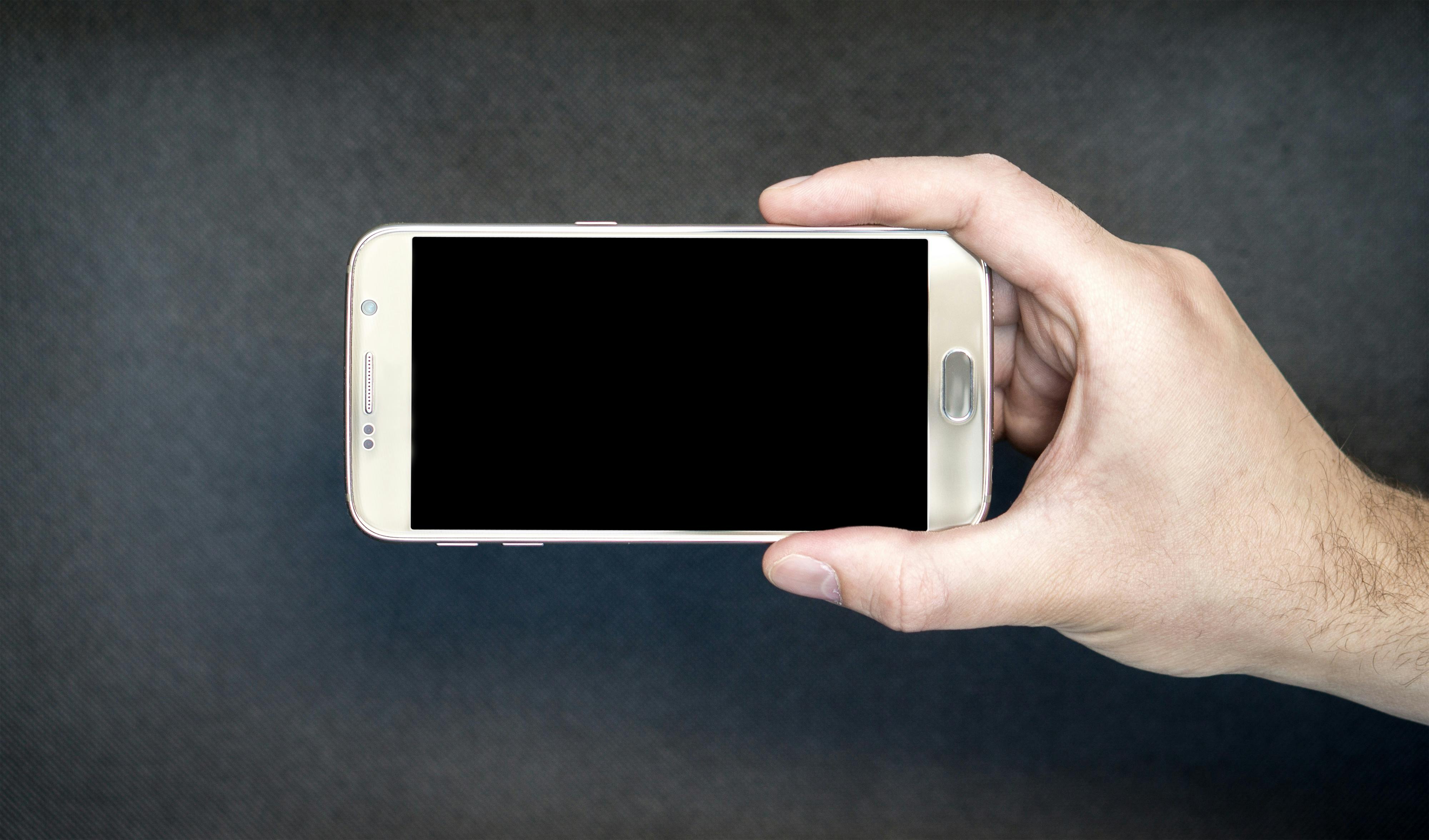With each added improvement in design, display technology, camera capabilities, and more, consumers are left pondering which device presents the better upgrade or switch between the Apple iPhone 15 Pro Max and the Google Pixel 8 Pro. The competition is particularly fierce this year, as both phones start at a premium threshold of over $1,000.
Design and Build Quality

Photo by Vanja Matijevic on Unsplash
Size and Weight Comparison
The Google Pixel 8 Pro and the Apple iPhone 15 Pro Max boast large displays housed in robust frames, yet they showcase differences in dimensions that cater to varied user preferences. The Google Pixel 8 Pro measures 162.6 x 76.5 x 8.8 mm and weighs 213 g, while the iPhone 15 Pro Max is slightly more compact and lighter, at 159.9 x 76.7 x 8.3 mm and 221 g. Despite their substantial screen sizes, these dimensions ensure both phones remain manageable for daily use. The subtle difference in weight between the two is unlikely to be discernible to users, emphasizing the emphasis on comfort alongside screen real estate in both designs.
Material and Aesthetic Differences
Material choices for the Apple iPhone 15 Pro Max and Google Pixel 8 Pro accentuate the premium nature of both devices. The iPhone 15 Pro Max transitions from stainless steel to a lighter and more refined aluminum/titanium build, coupled with a matte finish that exudes a sophisticated feel. The Pixel 8 Pro also makes a noteworthy shift to a frosted glass back, moving away from the previous generation's glossy finish, and introduces a flat front display. This choice of materials not only contributes to the durability and premium feel of the devices but also offers a tactile experience that is both comfortable and visually appealing.
Moreover, the iPhone 15 Pro Max implements a slight curvature towards the edges of its display glass, enhancing the ergonomic feel and ease of handling. The Pixel 8 Pro, while maintaining a more conventional form factor, matches this premium build quality with Gorilla Glass Victus 2 protection on both sides, offering resilience against drops and scratches.
Color options for these models are relatively subdued, with both companies offering variations of classic hues. However, the Pixel 8 Pro introduces a unique "Bay" color option, adding a touch of distinction to its lineup with a sky blue hue that stands out among standard colorways.
Display Comparison

"IPhone 15 Pro Max" by IPHONE 15 is licensed under CC BY-SA 4.0.
Screen Size and Resolution
Both phones boast impressive 6.7-inch displays, but they differ slightly in resolution. The Google Pixel 8 Pro comes with a 1344x2992 pixel LTPO OLED screen, offering a sharp and vibrant visual experience with a pixel density of 489 ppi. The Apple iPhone 15 Pro Max size dimensions on the other hand, feature a 1290x2796 pixel LTPO Super Retina XDR OLED display, with a slightly lower pixel density of 460 ppi. Despite these differences, both screens are capable of delivering deep blacks, bright colors, and detailed images that satisfy even the most discerning viewers.
Brightness and Color Accuracy
Where the displays truly differentiate themselves is in their brightness capabilities and color accuracy. The Google Pixel 8 Pro impresses with a peak manual brightness of 954 nits, slightly higher than the iPhone 15 Pro Max’s peak of 846 nits. However, in adaptive mode, the Apple iPhone 15 Pro Max edges ahead with a remarkable 1,787 nits, compared to the Pixel's 1,600 nits. Despite these differences, both displays offer excellent visibility under various lighting conditions.
When it comes to color accuracy, both devices excel in reproducing colors faithfully, with the iPhone 15 Pro Max having a slight edge due to its support for Dolby Vision, on top of HDR10 and HDR10+ standards that both phones support. This ensures that content viewed on these devices is not only bright and clear but also accurately represents the creator's intentions.
Refresh Rate and HDR Support
Both the Apple iPhone 15 Pro Max and the Google Pixel 8 Pro feature adaptive refresh rates up to 120Hz, allowing for smooth scrolling and animation while optimizing battery usage by adjusting the refresh rate based on the content being viewed. This feature ensures a fluid user experience across both devices, enhancing interactions whether navigating the interface, playing games, or watching videos.
Support for high dynamic range (HDR) content is a given for both devices. The iPhone's additional support for Dolby Vision enhances its already impressive HDR capabilities, providing viewers with an even more immersive viewing experience that brings movies and videos to life with astonishing clarity and depth.
Camera Features and Performance

"Texas23-2327-Dec 24 2023-2-40 PM-Pixel 8 Pro-Pixel 8 Pro back camera 18.0mm f-2.8" by LunchWithaLens is licensed under CC BY-NC-ND 2.0.
Main Camera Comparison
The cardinal asset of any flagship smartphone is its main camera, and both the Apple iPhone 15 Pro Max cameras and Google Pixel 8 Pro leave no stone unturned here. Spotting sophisticated lenses and sensors, these devices churn out images with minimal effort that are crisp, vibrant, and true to life. The iPhone 15 Pro Max, with its nuanced color science, leans towards slightly warmer tones, while the Pixel 8 Pro might edge out in terms of livelier color reproduction. However, the distinctions are subtle, boiling down to user preference.
Ultrawide and Telephoto Capabilities
When stretching the view with the ultrawide lens or zooming in with the telephoto lens, both phones exhibit an impressive range without significant loss of quality. The Google Pixel 8 Pro's ultrawide lens slightly outperforms the iPhone in sharpness. Conversely, at telephoto ranges, both handsets maintain commendable clarity and detail, with the Pixel 8 Pro showcasing superior noise performance. These insights carve out their niches: the Pixel 8 Pro excels in wider shots, while both phones are neck and neck in zoom capabilities.
Night Mode and Low-Light Performance
Pushing the envelope in low-light conditions, the Apple iPhone 15 Pro Max and Google Pixel 8 Pro each have their strengths. The iPhone 15 Pro Max offers a more conservative approach to Night mode, focusing on maintaining a natural look without over-brightening the scene. On the flip side, the Pixel 8 Pro tends to brighten shadows significantly, revealing more details in the darkest areas, though sometimes at the expense of noise. It's a trade-off between the natural preservation of a scene and drawing out more details from the shadows.
Portrait Mode and AI Features
In Portrait mode, both devices excel, blurring backgrounds with precision while keeping the subject sharp and in focus. However, the Google Pixel 8 Pro takes a slight edge with its advanced AI features, such as Magic Editor and Best Take, enhancing its utility for creative post-processing directly on the device. These features offer users the ability to manipulate their photos in ways that go beyond traditional camera settings, indicating Google's focus on software innovation.
Video Recording Quality
For videography enthusiasts, both smartphones boast excellent capabilities, with support for up to 4K60 FPS recording across all cameras. The Apple iPhone 15 Pro Max is particularly praised for its dynamic range, stabilizing more extreme situations smoothly. Meanwhile, the Google Pixel 8 Pro also delivers sharp, stabilized footage, although it may excel slightly more in ultrawide and regular frame detailing. Both devices offer professional-grade video quality suitable for a variety of content creation needs.
Performance and Hardware

"Google Pixel 8 Pro" by SimonWaldherr is licensed under CC BY-SA 4.0.
Chipsets: Apple A17 Pro vs. Google Tensor G3
At the heart of these flagships lie their powerful chipsets: Apple's A17 Pro and Google's Tensor G3. The Apple A17 Pro chipset, built on a 3 nm process, offers unparalleled performance, leading in benchmarks and real-world usage. The Google Tensor G3, while optimized for AI and machine learning tasks, focuses on delivering a seamless and fast user experience rather than purely outmatching in raw performance metrics. Despite the differences, both chipsets are tailor-made to harness the full potential of their respective ecosystems.
RAM and Storage Options
In terms of memory configurations, the Google Pixel 8 Pro starts with a base option of 12GB RAM and 128GB storage, whereas the Apple iPhone 15 Pro Max elevates its base model to 256GB storage backed by 8GB RAM. This divergence highlights a philosophical difference in how each brand views storage necessities and multitasking capabilities. Notably, both devices offer configurations up to 1TB, catering to users with high storage demands.
Battery Life and Charging Speed
Battery longevity and charging efficiency are crucial factors for today's smartphone users. The Apple iPhone 15 Pro Max demonstrates superior battery life, outlasting the Google Pixel 8 Pro in various usage scenarios, primarily due to its optimized chipset and software synergy. However, when it comes to charging speed, the Google Pixel 8 Pro takes the lead, boasting a faster charging time from 0 to 100 percent. This balance between battery duration and recharge speed is a vital consideration for those prioritizing uninterrupted usage and quick top-ups.
Software and Ecosystem

Image by Camilo Garcia from Pixabay
Operating System and Updates
The Apple iPhone 15 Pro Max operates on iOS, Apple's proprietary operating system renowned for its seamless usability, security features, and swift performance. One of the standout features of iOS is its timely updates. Apple devices are well known for receiving consistent updates that improve security, introduce new features, and extend the device's lifespan. Currently, iOS 17 supports devices going as far back as the iPhone XS series, which indicates Apple's commitment to supporting devices for approximately five years.
On the other hand, the Google Pixel 8 Pro runs on Android, offering a different style of customization and flexibility. Google has promised 7 years of software updates for its Pixel 8 lineup, potentially outpacing Apple in terms of long-term software support. This commitment suggests that the Pixel 8 Pro could continue to receive new features and security updates even when newer models have been released, providing an extended lifecycle for the device.
Integration within Apple and Google Ecosystems
The choice between these two devices may also depend on the ecosystem you're already invested in or plan to integrate into. Apple’s ecosystem is renowned for its seamless integration across devices. If you own an iPad, Mac, or Apple Watch, the Apple iPhone 15 Pro Max would enhance this interconnected experience. Features like AirDrop, iMessage, and Handoff contribute to a cohesive synergy that simplifies tasks and data sharing across devices.
Conversely, the Google Pixel 8 Pro offers deep integration with Google's suite of services, including Gmail, Google Drive, and Google Photos. For users reliant on Google's ecosystem for emails, document creation, and photo storage, the Pixel 8 Pro would be a natural fit. Additionally, the Pixel 8 Pro benefits from being Android's showcase device, often first in line to receive the newest Android features and updates directly from Google.
Pricing and Value for Money

Photo by Karolina Grabowska
Are the Apple iPhone 15 Pro Max and Google Pixel 8 Pro Worth It?
In the high-stakes world of flagship smartphones, pricing plays a pivotal role in a consumer's decision-making process. Both the iPhone 15 Pro Max and Google Pixel 8 Pro are premium devices with price tags to match, yet differences in pricing and storage options can influence perceived value for money.
The Apple iPhone 15 Pro Max price starts at $1,200 for the 256GB storage variant. This entry-level storage option is generous but also elevates the base price of the device. Apple offers this model in several color options and materials, including a new titanium finish, contributing to its premium feel and somewhat justifying its high cost.
Conversely, the Google Pixel 8 Pro is available at a slightly lower starting price of just over $1,000 for the same 256GB storage option. Notably, this makes the Pixel 8 Pro more accessible while still offering ample storage. Google's offering also includes a unique "Bay" color option, adding to its aesthetic allure.
While the Pixel 8 Pro's lower price point is attractive, especially considering its promised longevity through software updates and innovative AI features, the iPhone 15 Pro Max counters with superior build materials, a robust software ecosystem, and branding that carries its own premium cachet. Ultimately, the value for money will come down to individual priorities—whether it's the cutting-edge software and hardware integration offered by Apple or the long-term software support and slightly lower entry cost of the Google Pixel 8 Pro.






